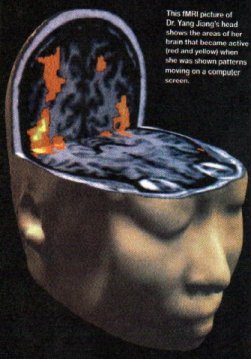

|
| This fMRI Picture of Dr. Yang Jiang's head shows the area of her brain that becomes active [red and yellow] when she's shown patterns moving on a computer screen. |
In recent years, they have discovered new ways to study the brain. Scientists can not watch the activities of different parts of our brain while it is at work. We can think of these techniques as new windows to our minds.
One new research method is called fMRI. It can take pictures of your brain in much the same way as an X-ray machine can take pictures of your bones. This method makes use of the fact that whenever a part of your brain becomes more active, it uses more oxygen.
If someone were to use this technique to study your brain, your head would be surrounded by a device that includes a big magnet. This device can detect tiny signals coming from oxygen. With the help of a computer, it turns these signals into pictures every few seconds, scientists can tell which parts of your brain become active when you think of something, such as multiplying three times ten.
Storing memories is one of the most important jobs our brain does. Without stored memories, we would not be able to recall new words we have learned or find our way home.
Everything we learn must be stored as memories in our brain. And storing a memory requires that something somewhere in our brain changes. Once a change is made, it must remain, even after the effort to learn has stopped. If the change doesn't remain, we will forget what we've learned.
Like the memory in our computers, most of our memories are stored away out of our awareness. But when we need them, they can be "copied" and temporarily placed in what is called our "working memory" for immediate use.
Dr Yang Jiang is one of the scientists using fMRI to learn more about how the brain works. She works in a laboratory at the National Institute of Mental Health in Besthesda, Maryland.
Dr. Jiang told me that she and her colleagues wanted to know more about where in the brain our working memories were kept. So they asked this question: where do we store the memory of a face we are looking for when we are surrounded by people we know?
For example, which parts of your brain are activated when you are at your brother's birthday party and want to find your mother in a room filled with other relatives? And then, once you've spoken to your mother, what happens when you want to find your brother to give him a gift?
Dr Jiang and her colleagues learned that when you want to search for your mother, you first put your memory of her face on one of your working memory. This is part that has the job of remembering who it is you are looking for. And this part is found near the front of your brain.
The memories of the other familiar faces, such as your brother's are kept in another part of your working memory. This is located near the back of the brain and has the job of letting you ignore the faces of people you are not seeking. When you see your mother's face, you activate those areas of the brain that control your movements toward her.
Next you want to give your brother the give you bought for him. Now his face will replace your mothers face in the part of your brain's working memory that has the job of remembering the person you are seeking.
Does all this research mean that we will soon be able to read others' minds and know what they are thinking? Most likely not, but for scientist like Dr. Jiang, there are plenty of more exciting experiments to do to learn more about how the brain works.
Here is one of the next questions Dr Jiang wants to ask: how does the brain perceive complex motion? This is like asking how and outfielder knows where to run to catch the baseball that is flying through the air.
If you were a scientist who studies the brain, what question would you like to ask?